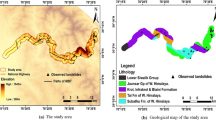Abstract
The present study investigates the factors associated with the occurrence of landslides along with the National Highway (NH 39) connecting Assam-Manipur (India) to Myanmar. Kinematics and slope stability analyses were used to gain an understanding of the causes of slope failure despite the terrain comprising material with a high safety factor. The study area falls within a high seismic zone along the regional Churachandpur-Mao Thrust (CMT) situated west of the Indo-Myanmar subduction zone. Based on these studies of seismicity, slip rates, creeping, among others, it was inferred that CMT is a creeping regional fault running parallel to the subduction zone boundary creeping segment of CMT and that the CMT requires further monitoring to assess the landslide hazard in the region.
Similar content being viewed by others
References
Bishop AW (1955) Use of slip circle in the stability of slopes. Geotechnique 5:7–17
Cradell DR, Varns DJ (1961) Movement of the Slumggullion earthflow near Lake city, Colorado. In: Short papers in geologic and hydrologic sciences: U.S. Geol Surv profession paper 424-B P.36-B139
Dawson EM, Roth WH (1999) Slope stability analysis with FLAC. In: Detournay C, Hart R (eds) Flac and numerical modeling geomechanics: proceedings of the conference. Balkema, Rotterdam, pp 3–9
Evan P (1932) Explanation notes to accompany a table showing the Tertiary succession in Assam Trans. Mining Geol Inst India 27:155–260
Fleming RW, Johnson AM (1989) Structures associated with strike-slip faults that bound landslide elements. Eng Geol 27:39–114
Gomberg JS, Bodin PW, Willam SZ, Jackson ME (1996) Slidequakes and fault creep at the Slumgullion landslide: an analog to crustal tectonics. In: Varns DJ, Seavage WZ (eds) The Slumgullion earthflow: a large-scale natural laboratory. U.S. Geol Bull 2130
Goodman RE (1976) Methods of geological engineering in discontinuous rocks. West Publishing, St. Paul, 472 pp
Hoek E, Bray JW (1981) Rock slope engineering, 3rd edn. Institution of Mining and Metallurgy, London, 402 pp
Hudson JA, Harrison JP (1992) Rock mechanics. Imperial College, London
Lump P (1975) Slope failure in Hong Kong. J Eng Geol 67:51–61
Malservisi R, Furlongb KP, Gans CR (2005) Microseismicity and creeping faults: hints from modeling the Hayward fault, California (USA). Earth Planet Sci Lett 234:421–435
Pant PD, Luirei K (2005) Amiya Landslide in the catchment of Gaula River, Southern Kumaun, Uttaranchal. Geol Soc India 65:291–295
Savage JC, Burford RO (1971) Discussion of paper by C.H. Scholz and T.J. Fitch, “Strain accumulation along the San Andreas Fault“. J Geophys Res 76:6469–6479
Savage WZ, Smith WK (1986) A model for the plastic flow of landslides. U.S. Geol Surv Professional Paper 138-S, 32 pp
Schuster RL, Wieczorek GF (2002) Landslide triggers and type. In: Jan R, Stemberk J (eds) Landslides: Proc 1st Eur Conf Landslides. Prague, Czech Republic, June 24–26, pp 59–77
Spencer E (1973) Thrust line criterion in embankment stability analysis. Geotechniques 23:85–100
Singh VK, Singh JK, Kumar A (1997) Slope design of the Maton rock phosphate mine. IGC-97, Vadodara, pp 585–588
Stephen WG, Kulhawy FH, Dubcan JM (1973) Accuracy equilibrium slope stability Analysis. J Soil Mech Found Div ASCE 99:783–791
Waldhauser F, Ellsworth WL (2002) Fault structure and mechanism of the Hayward fault, California from double difference earthquake location. J Geophys Res 107:2054
Wang YJ, Yin JH, Chen Z, Lee CF (2004) Analysis of wedge stability using different methods. Rock Mech Rock Eng 37:127–150
Yoan WS, Jeong OJ, Kim JH (2002) Kinematics analysis for sliding failure of multi-faced rock slope. Eng Geol 67:51–61
Zezere JL, Rodrigues ML (2002) Rainfall thresholds for landsliding in Lisbon area (Portugal). In: Jan R, Stemberk J (eds) Landslides: Proc 1st Eur Conf Landslides. Prague, Czech Republic, pp 333–338
Acknowledgements
The present studies were carried out under the financial assistance of a Department of Science Technology grant [no. DST/Seis/Mission/Landslide/2001(6)]; the authors gratefully acknowledge this grant. The various observations made by Shri Pradeep Singh and JRF and various discussions with Prof. O. P. Goel and R. K. Chadha during the revision of the manuscripts are gratefully acknowledged.
Author information
Authors and Affiliations
Corresponding author
Rights and permissions
About this article
Cite this article
Kumar, A., Sanoujam, M. Landslide studies along the national highway (NH 39) in Manipur. Nat Hazards 40, 603–614 (2007). https://doi.org/10.1007/s11069-006-9024-y
Received:
Accepted:
Published:
Issue Date:
DOI: https://doi.org/10.1007/s11069-006-9024-y




